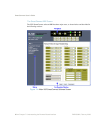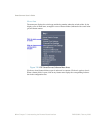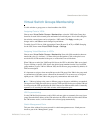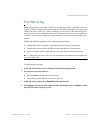
SmartConnect User’s Guide
98
Chapter 8: Virtual Switch Groups BMD00082, February 2009
Virtual Switch Groups Settings
Use this window to configure the following features for VSGs:
Delete the settings VSGs
Switch Failover
Link Aggregation Control Protocol (LACP)
IGMP Snooping
BPDU policy
Delete Virtual Switch Group Settings
Use the Delete drop-down list to remove all settings for a specific VSG or all VSGs. This
resets all configured settings for selected VSGs to their factory default values, including all
VSG-related settings made in other windows throughout the BBI. Ports assigned to the VSG
will be reassigned to default VSG 1. VMs and ACLs assigned to the VSG will be de-assigned.
Switch Failover
The primary application for Layer 2 failover is to support Network Adapter Teaming. With
Network Adapter Teaming, all the NICs on each server share the same IP address, and are con-
figured into a team. One NIC is the primary link, and the other is a standby link.
You can configure VSGs as failover trigger groups such that if some (or all) of the links fail in
a group, the VSE SmartConnect software disables all internal ports. When the internal ports
are disabled, it causes the NIC team on the affected server blades to failover from the primary
to the backup NIC. This process is called a failover event.
When the appropriate number of links return to service, the VSE SmartConnect software
enables the internal ports. This causes the NIC team on the affected server blades to fail back
to the primary switch (unless Auto-Fallback is disabled on the NIC team). The backup switch
processes traffic until the primary switch’s internal links come up, which takes up to five sec-
onds.
To configure Switch Failover (Layer 2 Failover) on a VSG:
1. In the Switch Failover drop-down list, select enable.
2. In the Number of Links to Trigger Failover drop-down list, select the trigger value.
3. Click Apply at the bottom of the window to make the changes active, and Save to retain
them beyond reboot and power cycles.


















